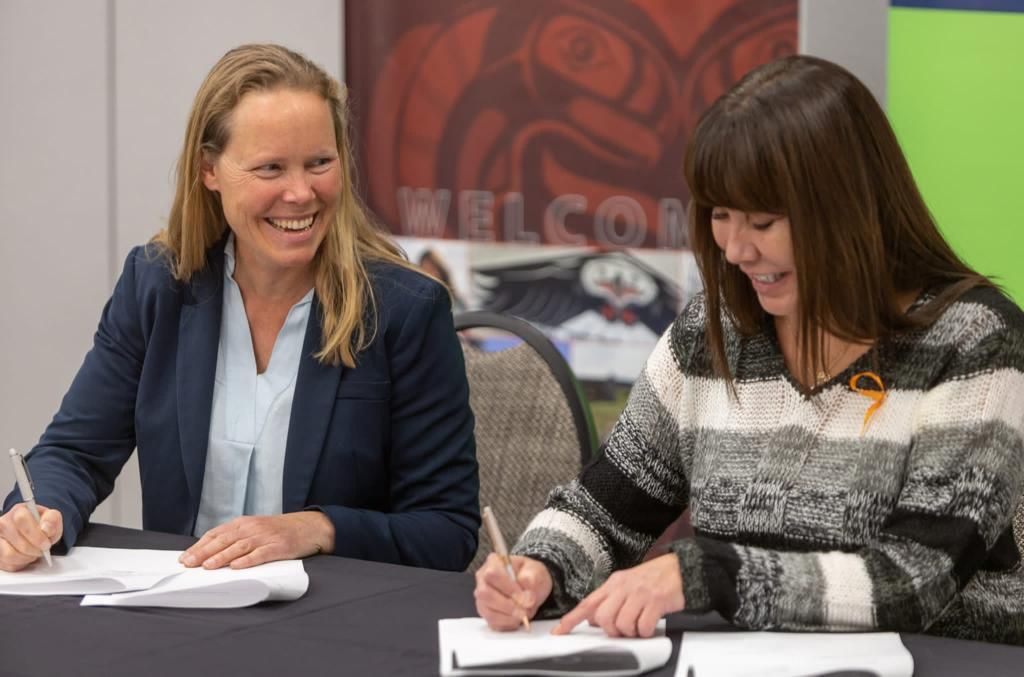Fortescue moves forward with hydrogen project in Prince George
Fortescue Future Industries (FFI), owned by mining giant Fortescue Metals, has submitted a proposal for a green hydrogen and ammonia production facility project in Canada’s British Columbia. Dubbed ‘Project Coyote’ the facility would be located in the city of Prince George in the centre of the Canadian province.
September 18, 2023 Carrie Hampel

Then Fortescue Future Industries CEO, Julie Shuttleworth, with Lheidli T'enneh Chief, Dolleen Logan, at the signing of the projects initial MoU in 2021.
Image: FFI
Share
    
Fortescue Future Industries’ planned facility, officially proposed at the Willow Cale Industrial Park in Prince George, should produce roughly 140,000 tonnes of hydrogen and 700,000 tonnes of ammonia per year, which would be used for both domestic use and export.
The USD 2 billion ($3.11b) ‘Project Coyote’ would need 1,000 MW of power from BC Hydro to create the green hydrogen by electrolysis, which would then be processed into green ammonia. The company has also begun the environmental approval process required by the provincial government.
The project has taken considerable planning with local and regional leaders. In the latter part of 2021, Fortescue signed Memoranda of Understandings (MoUs) with three Indigenous Nations in Canada, laying the ground for the conglomerate to plan green hydrogen projects across Canada. This included, among others, the Lheidli T’enneh First Nation in British Columbia, with whom the company has negotiated a benefit-sharing agreement.
Billionaire Andrew Forrest, who founded FFI and is currently executive chairman at parent company Fortescue Metals Group (FMG), travelled to Prince George to announce the project proposal. Forrest met with Lheidli T’enneh First Nation Chief Dolleen Logan during his visit.
“[Prince George has] got clean air. It’s got heaps of water. It’s got heaps of electricity. It’s got everything going for it, and so this first 1,000 MW facility sounds really big, but it’s a stepping stone to what could be built out here in this beautiful part of the world,” said Forrest, who spoke about the proposed facility during a presentation at the House of Ancestors on 13 September.
Earlier this year, the British Columbian government offered the city of Prince George funding over two years to support the city becoming a regional hub for hydrogen. The provincial government has identified Prince George as an ideal location given the industry’s foothold and promise in the region.
In 2022, Hydra Energy built what they claim is the world’s largest hydrogen refuelling station for heavy-duty trucks that have been converted to run on both hydrogen and diesel using Hydra’s conversion kits. The city has key infrastructure for distribution across the province. This includes its airport, highway intersection, and direct rail connections to the ports of Prince Rupert and Vancouver.
According to the local news outlet,Victoria News, Forrest has been vocal about exploring the potential of hydrogen production and export development in Canada and has been lobbying several other governments, including the US and UK governments, to set up renewable energy projects there. During the course of the hydrogen summit held in Newfoundland in 2022, German Chancellor Olaf Scholz and Canada’s Prime Minister Justin Trudeau also agreed to look into possible hydrogen exports from Canada to Germany, as well as agreements on battery materials for German production.
Fortescue is gaging similar projects in Canada, eyeing potential in Labrador, Nova Scotia, Quebec and Manitoba. Besides the MoU with Lheidli T’enneh First Nation in British Columbia, Fortescue has also made agreements with members of the Homeguard Cree First Nations in northern Manitoba and the Innu Nation in Newfoundland and Labrador.
Last year, Fortescue said it aims to be a global exporter of green hydrogen, with a goal to produce 15 million tonnes a year by 2030.
pv-magazine-australia.com |





